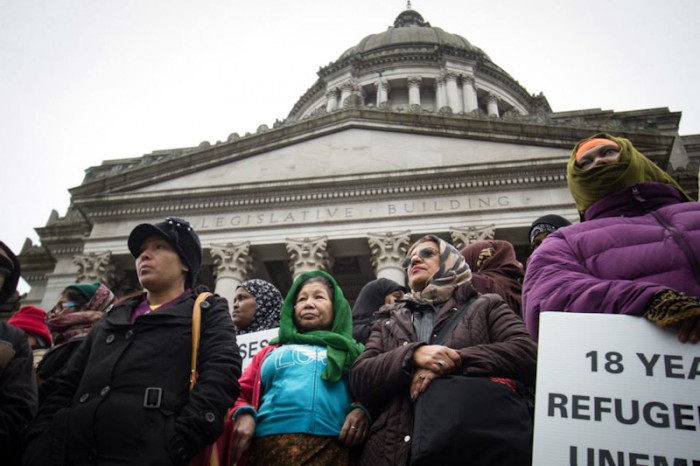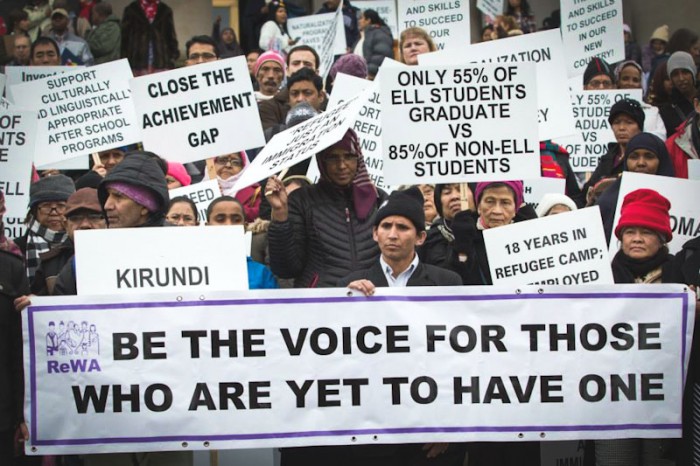The state legislative session comes to a close today. And despite celebration over the passage of the ‘Real Hope Act’ earlier in the session, in reality it’s been grim few years in Olympia for a subset of the population that’s often ignored politically — immigrants and refugees.
Budget cuts have gutted many state agencies and welfare assistance programs serving all Washingtonians, but the most vulnerable newcomers have been hammered on all sides.
“We see clients going through this every day,” said Mahnaz Eshetu, executive director of Refugee Women’s Alliance (ReWA). “When state legislators are looking at a budget, they cut from here and there, not thinking holistically. But if you cut food stamps, you cut mental health care or you don’t give enough money [to allow refugees] to speak to a counselor in their own culture, how do they act as a whole person? How do they get to the next level?”
It’s a familiar narrative among ReWA’s clients. Eshetu remembers a young Somali woman who had been in the U.S. no more than seven months. Despite small need grants and English language classes to assist in her job hunt, she explained through tears that her utilities had been cut after she defaulted on a bill.
Typically services like Temporary Assistance for Needy Families (TANF), a federal program providing aid to poor families, might be the small boost clients like Eshetu’s need. But a cut of $385 million in the 2009-10 budget year shrunk the average family of three’s benefits from $562 to $478 per month. TANF was cut again by another $126 million in 2012, prompting the program to reduce its caseload and for the first time see a funding surplus when coupled with federal contingency funds. Instead of reinvesting in needy families, more than $200 million was transferred into the General Fund.
The ripple effects, says Eshetu are client’s like her young Somali woman, who don’t have the language skills to navigate the system and can barely cover basic necessities even with welfare assistance.
Eshetu and her case managers point to four areas where budget cuts have impacted the more than 13 percent of Washington’s population who are immigrants and refugees:
Housing and Homelessness:
In 2010 the One Night Count calculated 1,152 homeless refugees and immigrants.
The real number, says case manager Hien Kieu is doubtlessly larger, but ReWA can often only track the issue anecdotally as families come through their door. Many stay in shelters, but many more combine households, cramming two or three families into one unit. Kieu says that means they fall outside traditional definitions of homelessness.
Like other high-risk groups, Eshetu lists cuts to the state’s Housing and Essential Needs (HEN) program and the Aged Blind and Disabled (ABD) program, as incendiaries from the last several rounds of budget cuts. In the case of ABD, which provides cash grants as small as $197 per month, such services are a critical safety net for elderly or disabled refugees not yet eligible for SSI or other federal benefits.
Naturalization Assistance:
“What happens if you don’t become a citizen? Then you’re not eligible for SSI [Social Security] or other services and you become reliant on other state and federal assistance,” says Eshetu. “It ends up hurting the state budget [even more].”
Naturalization assistance, a Citizenship101 course of sorts, coaches immigrants and refugees in everything from laws and regulations, to the political history of the U.S. and in more critical services like how to get a bank card or search for work.
Last year state services helped 1,327 low-income refugees and immigrants become citizens but a 2012 cut of 47 percent or $1.1 million jeopardizes future success stories.
State Food Assistance Program (SFA):
For immigrants and refugees not yet eligible for federal assistance, Washington’s SFA program is often their only food security lifeline. But in 2012 the Legislature reduced the benefit level for refugees and immigrants by 50 percent.
Last year, that cut was restored partially by raising the benefit level to 75 percent of the federal food stamp index. Still, it has grave implications for the roughly 15,000 kids who directly or indirectly benefit from SFA by sharing a household with a beneficiary.
K-12 Education:
Washington’s slow progress on the McCleary ruling presents both opportunity and concern, says Eshetu, for ELL programs in the state’s public schools. Last school year, nine percent of the student body were enrolled in English Language Learner programs, and yet only 1.2 percent of state funding was allocated to them.
Those numbers manifest themselves in widening achievement gaps, she says. The dropout rate for ELL students is 26 percent, nearly double that of the statewide average and ELL students score consistently lower than their peers in academic assessments. Only 55 percent met reading standards versus the 78 percent for whom English was their primary language.
“[ELL] programs don’t necessarily have people of the same culture or language capability teaching [students],” says Eshetu. “So we need to find ways to supplement them.”
Sometimes reminding legislators of the sheer size of the state’s community is enough. At this year’s Immigrant and Refugee Legislative Day, on February 11th, 800 immigrants, refugees and their allies turned out to demonstrate their political force.
“Families come over here and they’re getting paid minimum [wage]. Their housing is not sufficient and their food stamps are being cut,” says Eshetu. “When you’re faced with all this hardship, your basic needs can’t even be met, how can you learn anything if you’re going through all that stress?”




Just wanted to share there is a special event on April 17 and 18 called “Latino Health”
http://www.grouphealthresearch.org/news-and-events/events/latino-health.html
Disparity is one of the themes.
Thank you Jamesian! We’ll post this to our events calendar too.